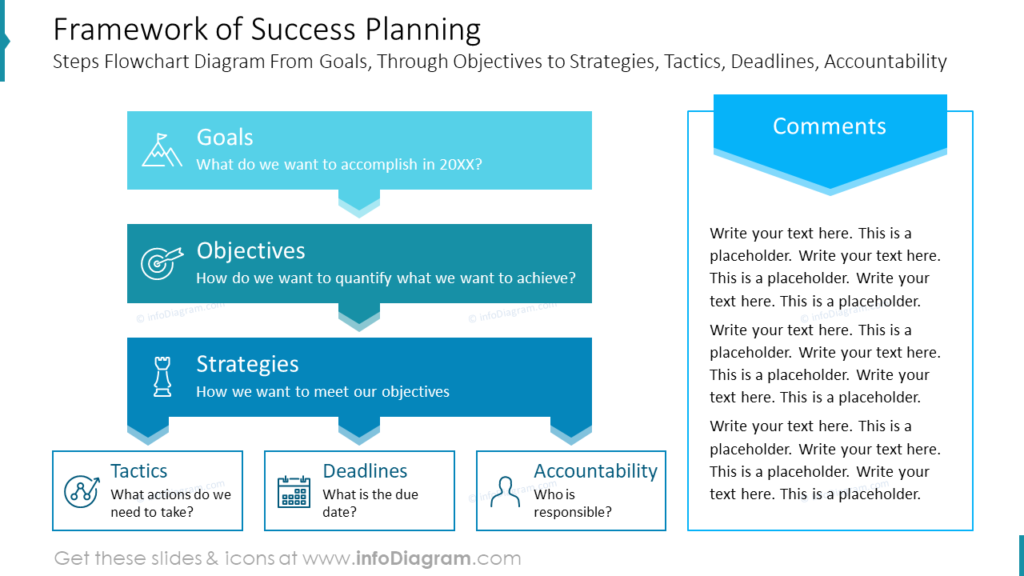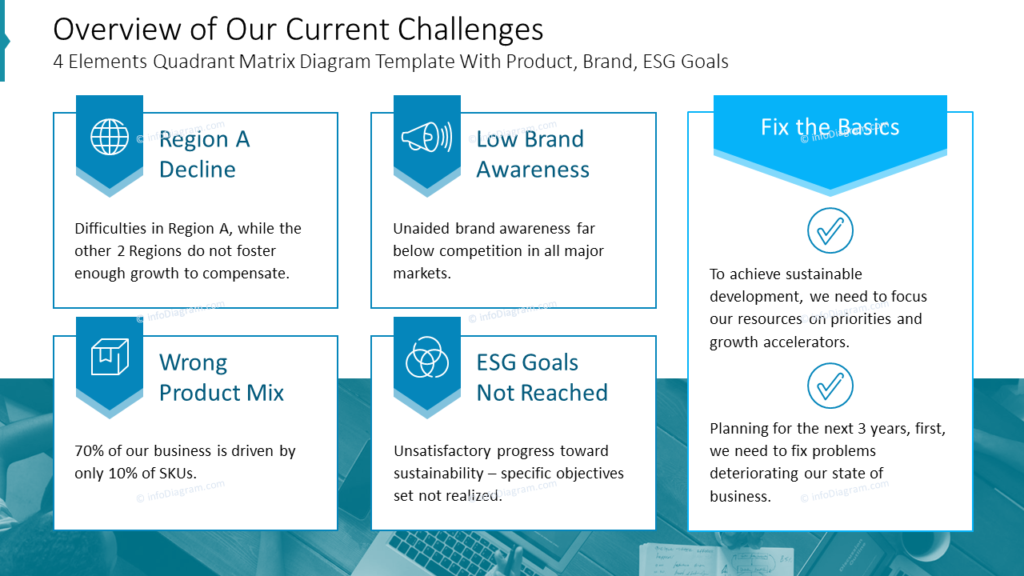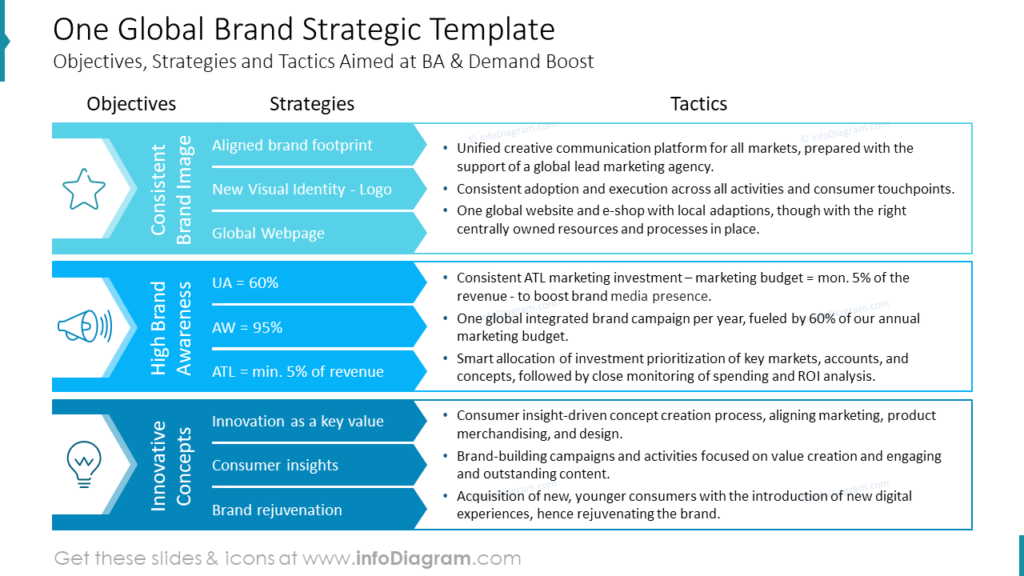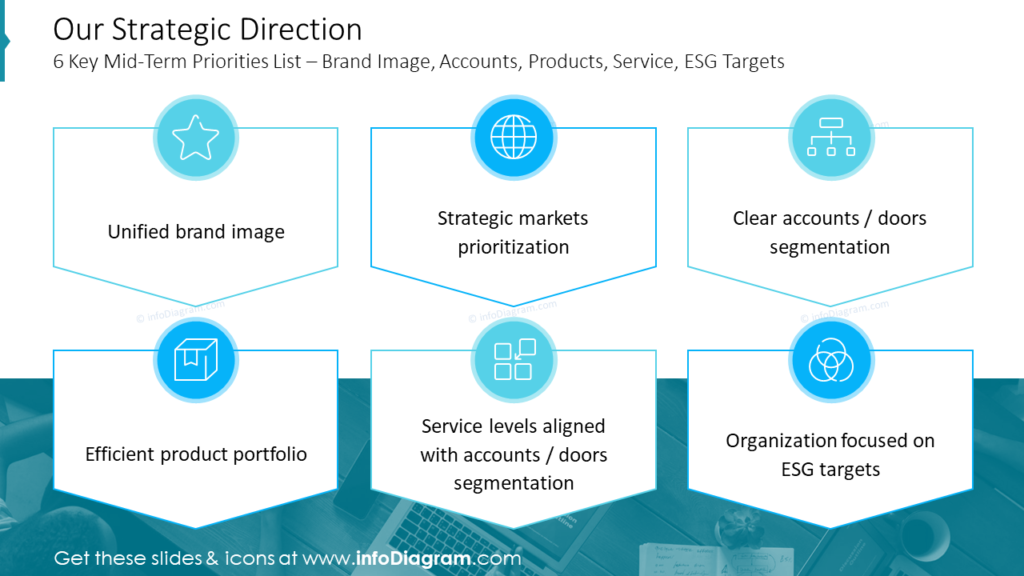Secrets of Successful Business Planning: Business Plan Example Graphics
Writing a business plan is an essential part of building a successful company. At its core, such a plan is a road map that establishes the purpose and sets goals and expectations. In this blog, I’ll discuss the necessary parts of the business plan example and show you how you can illustrate them so your presentation looks professional.
However, as Thomas Edison rightly pointed out, vision without execution is a hallucination and statistics show that only 10% of strategic plans are effectively executed. How come? I have seen many business plans where detailed tactics, action plans, or RASIC were missing. In my opinion, those elements are the cornerstone of effective execution since they clarify expectations and accountability, align individuals and teams around a common objective, and ensure adequate resources are allocated. Your business objectives should always be specific, measurable, achievable, relevant, and time-bound. Without well-defined objectives, it will be difficult to measure your progress and determine whether or not you are achieving your goals.
Any of you who have prepared an annual or multi-year business plan have undoubtedly encountered some challenges. You may be crystal clear about what you want to achieve. But showing your audience the path to reach the goals set can be a bit tricky. As mentioned before some business plans lack specific tasks and responsibilities assigned. On the other hand, some are overpacked with activities that we plan to undertake, they are full of data and analysis and they are just difficult to embrace.
Get all the graphics presented here – click on the slide pictures to see and download the source illustration. Check the full Corporate Business Plan Presentation with the ESG Strategy deck here.
What is a business plan?
A business plan defines a company’s objectives, tactics, and actions required to achieve set goals. It typically explores the competitive landscape of an industry, analyzes the market situation, and lists current business challenges and strategies for success. A business plan is the basis for the company’s budget in which the company’s targets are translated into a concrete financial plan.
Why use a visual way to present a business plan example?
If you need to outline the path your business needs to take to grow revenue in the next few years, use our creative business plan example template. It will allow you to pinpoint the main business challenges and strategic direction in an eye-catching and easy-to-understand format. Share your plans in a clear and comprehensible way to align all the stakeholders toward a collective objective for the company.
A framework of easy-to-understand business plan
How to write a solid business plan without falling into the trap of it being either inadequate, illegible, or simply too long and boring to digest?
Have a look at the framework of success planning. It is a logical sequence of elements that need to be incorporated into our business plan so that it is clear and executable.
Below is an example of how you can visualize such a slide.

This slide illustrates a structured approach to success planning, laid out as a flowchart that connects different stages of the planning process. Each stage of the plan is highlighted in a distinct blue-colored banner that labels the step and provides a brief guiding question or statement related to that phase. The icons adjacent to the labels offer a visual cue about the content of each step:
- “Goals” with a mountain summit icon signifies setting the targets to achieve.
- “Objectives” with a target suggests defining measurable benchmarks.
- “Strategies” with a chess piece indicates devising methods to achieve the objectives.
- “Tactics” with a chart icon refers to specific actions required.
- “Deadlines” with a calendar icon denotes setting timeframes.
- “Accountability” with a person asks to assign responsibilities.
To the right, there’s a large “Comments” section in a matching blue banner where additional notes can be added. This visual layout is designed to facilitate a clear understanding of the planning process, breaking down complex goals into manageable tasks.
Now, let me give you some hints, directly from my experience. They can help you create a business plan that is easy to read, understand, and carry out, the one that is engaging and motivating to act on.
Show Point of Departure in Your Business Plan Presentation
Firstly, don’t write a business plan detached from reality and the situation you’re in. Present your point of departure or the current state of your company. Address the main challenges your business faces and translate them into concrete solutions that you can act on.
Here’s how you can showcase an overview of the current challenges:

This slide features a quadrant matrix diagram that categorizes key challenges. Each quadrant highlights a specific issue, with a descriptive icon for quick reference:
- “Region A Decline” is indicated by a globe icon, signifying geographical challenges, noting difficulties in Region A with insufficient growth in other regions.
- “Low Brand Awareness” is marked by a megaphone icon, pointing to the issue of brand recognition being significantly lower than competitors.
- “Wrong Product Mix” is shown with a box icon, illustrating a product strategy issue where a small percentage of products drives most of the business.
- “ESG Goals Not Reached” is accompanied by a Venn diagram symbol, signaling that some of the environmental, social, and governance targets have not been met.
You need to be clear about your priorities. What are the most important things you need to accomplish to make your business successful? If you don’t prioritize, you run the risk of getting bogged down in details and forgetting what’s truly important to your business. So take the time to sit down and figure out what your priorities are.
Present a Roadmap to Success
Secondly, be methodical with it. As mentioned above, break down your challenges one by one and describe in detail the objectives you want to achieve, with a concrete pathway from strategy to tactics and specific actions. A bit like in the case of a typical pitch deck, shows the problem, the solution, and the way to get there.
Let’s have a look at the slide below which outlines objectives, strategies, and tactics for achieving brand alignment and demand enhancement.

It’s segmented into three columns:
- The first column – Objectives – uses symbols like a star, megaphone, and light bulb to represent different goals such as “Consistent Brand Image,” “High Brand Awareness,” and “Innovative Concepts.”
- The second column – Strategies – details plans like “Aligned brand footprint,” indicating the creation of a new visual identity with a logo and a global webpage, along with key performance indicators (KPIs) such as a 60% unaided awareness (UA) and a minimum of 5% of revenue dedicated to above-the-line (ATL) marketing.
- The third column, “Tactics,” describes actionable steps such as developing a unified creative communication platform, ensuring consistent investment in ATL marketing, and adopting consumer insight-driven approaches for brand rejuvenation.
Use Captivating Format for Business Plan Slides
Thirdly, make your business plan interesting and appealing. If you want to present your strategies simply and understandably to your key stakeholders you can use ready-made, structured, and editable templates that will help you to present your ideas in an eye-catching and attractive format.
For example, the slide below presents the strategic direction containing 6 mid-term priorities, focusing on brand image, accounts, products, services, and ESG (Environmental, Social, and Governance) targets.

The slide is organized into three columns and two rows, each housing key strategic focus areas:
- The top row emphasizes “Unified brand image,” “Strategic markets prioritization,” and “Clear accounts/doors segmentation”. Each is accompanied by an icon symbolizing the concept: a star for brand image, a globe for market prioritization, and a flowchart icon for account segmentation.
- The bottom row highlights “Efficient product portfolio,” “Service levels aligned with accounts/doors segmentation,” and “Organization focused on ESG targets”. Again, each with a representative icon: a box for product efficiency, a puzzle for service alignment, and a Venn structure for ESG focus.
Realistic Assumptions
And lastly, have feasible plans in mind. Too often, we tend to go to extremes with the numbers. Your business plan should be based on realistic assumptions and projections, not wishful thinking. If you’re too optimistic about your business plan, achieving your goals will be very difficult. Please remember also that your business plan is not a static document. It should be reviewed and revised regularly to ensure that it remains relevant and up-to-date. As your business grows and changes, you may find that some of the goals and objectives in your original plan need to be validated or achievable. Your plans should also be constantly adapted to evolving market conditions, industry, or competition around you.
Corporate Business Plan as a Powerful Tool
To sum up, preparing and drafting a business plan is a versatile and powerful tool that will help you run your business thoughtfully and successfully. It is worthwhile to take care of its sound drafting and execution so that the words of Thomas Edison do not apply to our company. To avoid failure ensure that every employee understands what the goals are, focus on a select few relevant initiatives that are high priorities for success, commit adequate and appropriate resources, and hold people accountable.
Resource: Corporate Business Plan Example PowerPoint Presentation
In the examples above, I used the graphics from a PowerPoint template with business plan presentation visuals. You can check all source slides in the infoDiagram collection of presentation graphics:
Continue Exploring
Looking for more ideas and inspiration? Check our resources:
- How to Stand Out With Impactful ESG Sustainability Report PowerPoint Presentation
- Illustrating Company’s Performance: Tips and Tricks for Successful Presentation
- Action Plan Template Examples: How to Stay on Track and Boost Productivity
- How to Illustrate Financial Results in PowerPoint [YouTube movie]
Author: Katarzyna Podlejska, Independent Business Consultant



